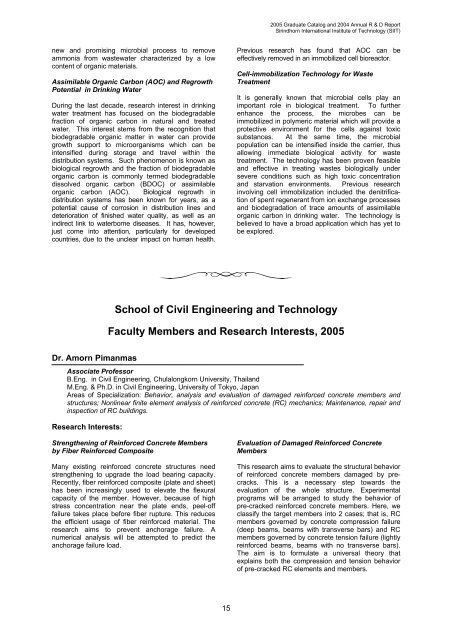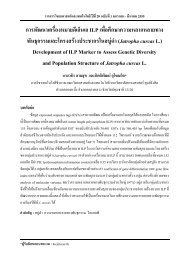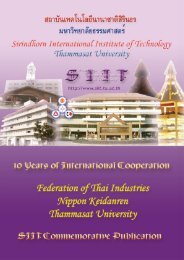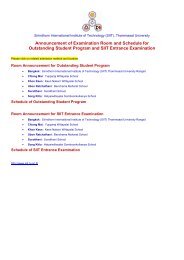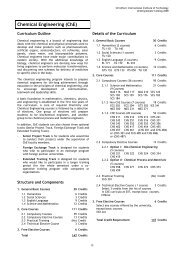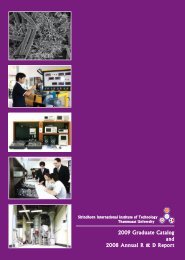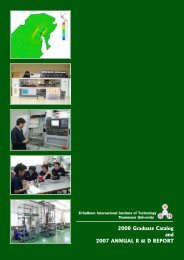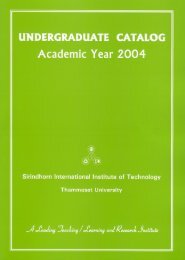2005 Graduate Catalog and 2004 Annual R & D Report - Sirindhorn ...
2005 Graduate Catalog and 2004 Annual R & D Report - Sirindhorn ...
2005 Graduate Catalog and 2004 Annual R & D Report - Sirindhorn ...
- No tags were found...
Create successful ePaper yourself
Turn your PDF publications into a flip-book with our unique Google optimized e-Paper software.
<strong>2005</strong> <strong>Graduate</strong> <strong>Catalog</strong> <strong>and</strong> <strong>2004</strong> <strong>Annual</strong> R & D <strong>Report</strong><br />
<strong>Sirindhorn</strong> International Institute of Technology (SIIT)<br />
new <strong>and</strong> promising microbial process to remove<br />
ammonia from wastewater characterized by a low<br />
content of organic materials.<br />
Assimilable Organic Carbon (AOC) <strong>and</strong> Regrowth<br />
Potential in Drinking Water<br />
During the last decade, research interest in drinking<br />
water treatment has focused on the biodegradable<br />
fraction of organic carbon in natural <strong>and</strong> treated<br />
water. This interest stems from the recognition that<br />
biodegradable organic matter in water can provide<br />
growth support to microorganisms which can be<br />
intensified during storage <strong>and</strong> travel within the<br />
distribution systems. Such phenomenon is known as<br />
biological regrowth <strong>and</strong> the fraction of biodegradable<br />
organic carbon is commonly termed biodegradable<br />
dissolved organic carbon (BDOC) or assimilable<br />
organic carbon (AOC). Biological regrowth in<br />
distribution systems has been known for years, as a<br />
potential cause of corrosion in distribution lines <strong>and</strong><br />
deterioration of finished water quality, as well as an<br />
indirect link to waterborne diseases. It has, however,<br />
just come into attention, particularly for developed<br />
countries, due to the unclear impact on human health.<br />
Previous research has found that AOC can be<br />
effectively removed in an immobilized cell bioreactor.<br />
Cell-immobilization Technology for Waste<br />
Treatment<br />
It is generally known that microbial cells play an<br />
important role in biological treatment. To further<br />
enhance the process, the microbes can be<br />
immobilized in polymeric material which will provide a<br />
protective environment for the cells against toxic<br />
substances. At the same time, the microbial<br />
population can be intensified inside the carrier, thus<br />
allowing immediate biological activity for waste<br />
treatment. The technology has been proven feasible<br />
<strong>and</strong> effective in treating wastes biologically under<br />
severe conditions such as high toxic concentration<br />
<strong>and</strong> starvation environments. Previous research<br />
involving cell immobilization included the denitrification<br />
of spent regenerant from ion exchange processes<br />
<strong>and</strong> biodegradation of trace amounts of assimilable<br />
organic carbon in drinking water. The technology is<br />
believed to have a broad application which has yet to<br />
be explored.<br />
School of Civil Engineering <strong>and</strong> Technology<br />
Faculty Members <strong>and</strong> Research Interests, <strong>2005</strong><br />
Dr. Amorn Pimanmas<br />
Associate Professor<br />
B.Eng. in Civil Engineering, Chulalongkorn University, Thail<strong>and</strong><br />
M.Eng. & Ph.D. in Civil Engineering, University of Tokyo, Japan<br />
Areas of Specialization: Behavior, analysis <strong>and</strong> evaluation of damaged reinforced concrete members <strong>and</strong><br />
structures; Nonlinear finite element analysis of reinforced concrete (RC) mechanics; Maintenance, repair <strong>and</strong><br />
inspection of RC buildings.<br />
Research Interests:<br />
Strengthening of Reinforced Concrete Members<br />
by Fiber Reinforced Composite<br />
Many existing reinforced concrete structures need<br />
strengthening to upgrade the load bearing capacity.<br />
Recently, fiber reinforced composite (plate <strong>and</strong> sheet)<br />
has been increasingly used to elevate the flexural<br />
capacity of the member. However, because of high<br />
stress concentration near the plate ends, peel-off<br />
failure takes place before fiber rupture. This reduces<br />
the efficient usage of fiber reinforced material. The<br />
research aims to prevent anchorage failure. A<br />
numerical analysis will be attempted to predict the<br />
anchorage failure load.<br />
Evaluation of Damaged Reinforced Concrete<br />
Members<br />
This research aims to evaluate the structural behavior<br />
of reinforced concrete members damaged by precracks.<br />
This is a necessary step towards the<br />
evaluation of the whole structure. Experimental<br />
programs will be arranged to study the behavior of<br />
pre-cracked reinforced concrete members. Here, we<br />
classify the target members into 2 cases; that is, RC<br />
members governed by concrete compression failure<br />
(deep beams, beams with transverse bars) <strong>and</strong> RC<br />
members governed by concrete tension failure (lightly<br />
reinforced beams, beams with no transverse bars).<br />
The aim is to formulate a universal theory that<br />
explains both the compression <strong>and</strong> tension behavior<br />
of pre-cracked RC elements <strong>and</strong> members.<br />
15


